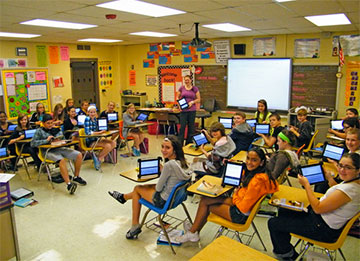 How Wireless Technology Is Empowering Parents, Teachers, And Students
How Wireless Technology Is Empowering Parents, Teachers, And Students
Technology is pushing the world forward at an accelerated rate. In the workplace, it’s a given that technology is essential for processing workflow, improving productivity, reducing overheads, and stimulating profits. However, in schools, it’s still considered something of a revolutionary concept. Critics, usually an older generation of educators who remember their own distant childhood, claim it’s a distraction and books and mobile devices don’t play well together.
However, Mobile Future Chair Jonathan Spalter, has beautifully summarized the argument for wireless technology in the classroom: “Wireless technologies are offering students, along with their parents, caregivers and the teachers who instruct them, fresh, engaging and constantly evolving ways of learning about, and examining, the world around them. With continued investment and innovation in wireless, mobile will continue to transform American education and help ensure all of our young people have the tools they need to succeed in today’s and tomorrow’s wireless world.”
Perhaps, one of the best ways of understanding the positive impact of wireless technology in schools is to look at the benefits of communication through a mobile device through the eyes of teachers, parents, and students.
A Teacher’s Perspective
Teaching is a difficult profession. Sometimes, it appears that teachers have to be in several places at the same time. Inside the classroom, they have to present lessons, organize student activities, and deal with disciplinary issues. Outside the classroom, they have to write lesson plans and grade papers. Then, on top of this, they act as intermediaries between parents and students, connecting the two different spheres of influence together.
Given their busy, perhaps even frenetic schedule, it’s often difficult for teachers to find the time to call parents, meet with students after hours, or arrange meetings between parents and their children in a classroom. It’s taking away precious time from doing other important activities that also have to get done.
With mobile technology, all these problems are resolved with a few taps on a mobile phone or tablet. Teachers can use software programs like the Meridian PRIME eplanner to send out homework assignments to students’ devices. They can use email to contact parents. Or they can use a website to post updates on information important for students or parents.
In short, wireless technology allows a teacher to perform a number of critical tasks quickly and more efficiently than ever before. The right applications open up the line of communication to everyone. A single email, for instance, sent to multiple addresses can inform all parents simultaneously about an important school event…or a simple push of a button can send all students in a class updates on their homework assignment.
A Parent’s Perspective
Parents too are busy. Some work two jobs to earn enough to support a family; some have long commutes; and some have hectic work shifts. It’s often extremely difficult to take time off from work to travel to a classroom meeting to get an update on their child’s progress.
If a child is acting out in school or is uncommunicative about when school reports are due, it’s easy for parent-child relationships to be strained. Technology enables parents to find out about their child’s academic performance, monitor any behavior problems in school, get report cards, and stay updated on important school events.
Again, lines of communication are kept open between all parties. It’s hard for children to feel that their parent’s don’t care when their parents are well-informed about everything important that is happening in their child’s life and can discuss problems that need to be resolved at the dining table in the evening.
A Student’s Perspective
Student’s, perhaps, benefit the most from wireless technology. For parents and teachers, technology is a means to facilitate fast and convenient communication, but for student’s technology does more than serve as a means of rapid communication.
Students can use technology as an organizer—to schedule classes, homework assignments, and ask teachers and peers questions on what to do when stuck. Should a student miss class due to illness or an athletic event, notes can be sent to them about what happened in class and what assignments were handed out. They can also monitor their progress.
Students can also use technology to learn better and faster through self-paced learning than listening to a teacher. In order to understand this remarkable phenomena, here’s a a brief description from The Economist on a new concept in education called “flipping the classroom:”
“THE 12-year-olds filing into Courtney Cadwell’s classroom at Egan Junior High in Los Altos, a leafy suburb of Silicon Valley, each take a white MacBook from a trolley, log on to a website called KhanAcademy.org and begin doing maths exercises. They will not get a lecture from Ms Cadwell, because they have already viewed, at home, various lectures as video clips on KhanAcademy (given by Salman Khan, its founder). And Ms Cadwell, logged in as a “coach”, can see exactly who has watched which. This means that class time is now free for something else: one-on-one instruction by Ms Cadwell, or what used to be known as tutoring.”
This is astonishing. It basically means that students find it much easier to learn from computers than they do from live teaching while also getting personal, one-on-one attention from the teacher.
Converging Perspectives
Before the advent of mobile devices, technology was limited to desktops and laptops. Now parents, teachers and students are literally on the same page, sharing information and perspective through the right apps on their respective devices.


Pingback: Empowerment | Pearltrees